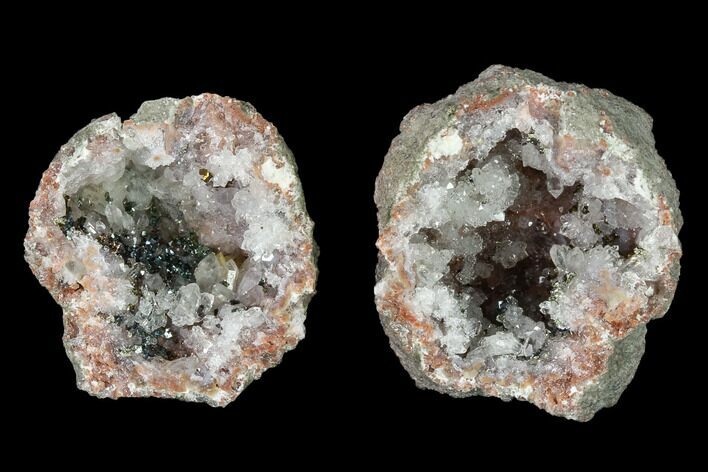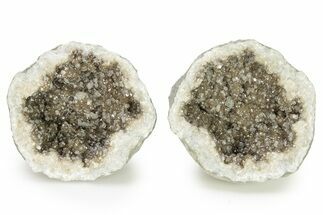This Specimen has been sold.
1.3" Keokuk "Red Rind" Geode with Iridescent Chalcopyrite - Iowa
This is a beautiful, sparkling quartz "red rind" geode from the Keokuk area of Iowa. It's been cracked open to reveal an interior lined with glimmering, clear quartz crystals and iridescent chalcopyrite crystals. Both halves are included.
These specific geodes are called "red rind" geodes due to the reddish coloration of their sides. They come from only a couple of specific sites in the Keokuk area and are know for their water clear quartz crystals.
These specific geodes are called "red rind" geodes due to the reddish coloration of their sides. They come from only a couple of specific sites in the Keokuk area and are know for their water clear quartz crystals.
Unlike most geodes that form in volcanic rock, Keokuk geodes are found in sedimentary rock. They started out as concretions of mud that formed around organic material about 340 million years ago. The outer shells of these concretions were subsequently replaced by chalcedony and the interiors of the concretions were dissolved, leaving a hollow space into which quartz crystals could grow. Most geodes are 2 to 5 inches wide, though specimens as large as two feet across have been found.
Keokuk geodes contain a variety of minerals, but quartz is dominant in most. Many geodes are filled with clear to white quartz crystals. Micro-crystalline quartz, or chalcedony, whose component crystals are too small to be seen with the naked eye, forms the outer shell. Chalcedony layers also encrust the interior walls of many geode cavities, covering the surfaces of the earlier-generation quartz crystals in a variety of colors, including white, gray, blue, yellow and orange. Calcite is also a common mineral in many geodes, though seventeen other minerals have been identified in Keokuk Geodes, including pyrite and sphalerite.
The area around Keokuk, Iowa is sometimes referred to as “the geode capital of the world". In 1967, these geodes were even named the official state rock of Iowa. Geodes have been collected from the Lower Warsaw Formation within about 100 miles of the city for over 150 years.
Keokuk geodes contain a variety of minerals, but quartz is dominant in most. Many geodes are filled with clear to white quartz crystals. Micro-crystalline quartz, or chalcedony, whose component crystals are too small to be seen with the naked eye, forms the outer shell. Chalcedony layers also encrust the interior walls of many geode cavities, covering the surfaces of the earlier-generation quartz crystals in a variety of colors, including white, gray, blue, yellow and orange. Calcite is also a common mineral in many geodes, though seventeen other minerals have been identified in Keokuk Geodes, including pyrite and sphalerite.
The area around Keokuk, Iowa is sometimes referred to as “the geode capital of the world". In 1967, these geodes were even named the official state rock of Iowa. Geodes have been collected from the Lower Warsaw Formation within about 100 miles of the city for over 150 years.
About Quartz
Quartz is the name given to silicon dioxide (SiO2) and is the second most abundant mineral in the Earth's crust. Quartz crystals generally grow in silica-rich environments--usually igneous rocks or hydrothermal environments like geothermal waters--at temperatures between 100°C and 450°C, and usually under very high pressure. In either case, crystals will precipitate as temperatures cool, just as ice gradually forms when water freezes. Quartz veins are formed when open fissures are filled with hot water during the closing stages of mountain formation: these veins can be hundreds of millions of years old.
Quartz is the name given to silicon dioxide (SiO2) and is the second most abundant mineral in the Earth's crust. Quartz crystals generally grow in silica-rich environments--usually igneous rocks or hydrothermal environments like geothermal waters--at temperatures between 100°C and 450°C, and usually under very high pressure. In either case, crystals will precipitate as temperatures cool, just as ice gradually forms when water freezes. Quartz veins are formed when open fissures are filled with hot water during the closing stages of mountain formation: these veins can be hundreds of millions of years old.
Chalcopyrite is a brass-yellow colored mineral and an important copper ore. When weathered, chalcopyrite loses its metallic luster, turning a gray-green color. When exposed to acids, the tarnish can develop a red, blue, or purple iridescence: this acid-treated material is often sold under the name peacock ore.
SPECIES
Quartz & Chalcopyrite
LOCATION
Keokuk area, Iowa
SIZE
1.3" wide (each half)
CATEGORY
SUB CATEGORY
ITEM
#141503
 Reviews
Reviews













